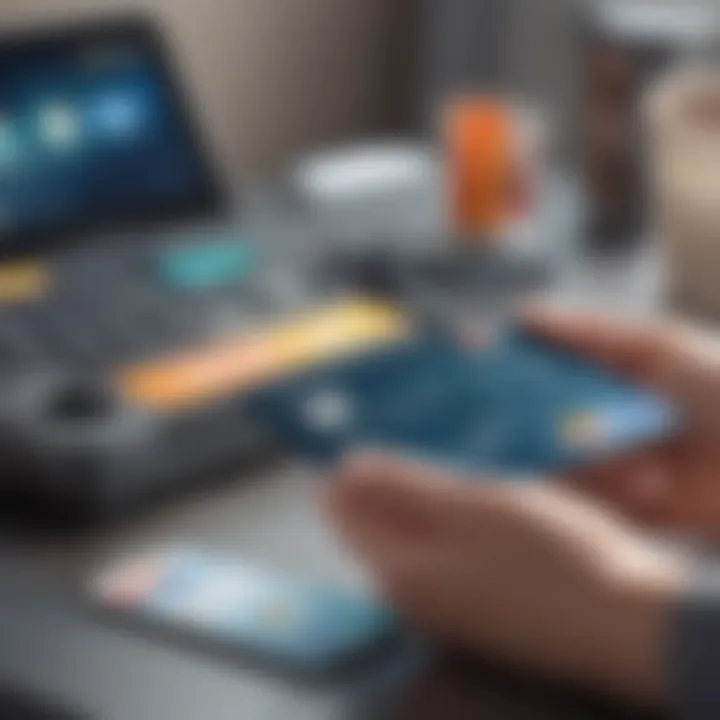Mastering Online Payments with Apple Wallet


Intro
The digital payment landscape has changed rapidly in recent years. With the rise of smartphones and mobile technologies, various methods for making transactions online have emerged. Apple Wallet is one of these solutions that has gained significant traction. This guide will navigate through the ins and outs of using Apple Wallet for online purchases, making sense of its key features, and shedding light on its advantages over other payment methods.
As we delve deeper, we will explain how to set up Apple Wallet, ensuring that you have a smooth sailing experience when shopping online. We will also explore the security measures that Apple employs, an essential factor that any tech-savvy shopper must consider.
Additionally, this article will highlight some common scenarios where Apple Wallet shines in comparison to traditional payment methods. With a blend of practical tips and expert insights, readers will gain a comprehensive understanding of effectively leveraging this tool for their online shopping needs.
Investment Definitions
Understanding various aspects related to online payments can empower consumers and investors alike to make more informed choices. Here, we outline relevant terminology connected to Apple Wallet and online transactions.
Key Terms Explained
- Digital Wallet: A digital wallet is an application that stores payment information securely and allows users to make electronic transactions. Apple Wallet is a prime example.
- Tokenization: This is a security process that replaces sensitive information with a non-sensitive equivalent, or “token.” Apple Wallet uses tokenization to protect users’ card details.
- NFC (Near Field Communication): A set of communication protocols that enables data exchange between devices over short distances, crucial for touchless transactions.
- Peer-to-Peer Payments (P2P): Allowing individuals to transfer funds directly to another person, typically through mobile apps, including Apple Wallet.
Understanding these terms is fundamental as they provide the groundwork needed to grasp the mechanics behind Apple Wallet and its capabilities.
Common Payment Strategies
- In-App Purchases: Making transactions directly within apps using Apple Wallet for convenience.
- Contactless Payments: Utilizing NFC technology, Apple Wallet enables users to pay by simply tapping their phones at supported terminals.
- Subscription Services: Many services now allow recurring charges through digital wallets, providing a streamlined payment experience automating hobby subscriptions or regular utilities.
Having a solid grasp of these concepts can pave the way for realizing the true potential of Apple Wallet in everyday transactions. It not only simplifies payment procedures but also enhances security protocols.
Expert Advice
Navigating the world of digital payments requires a mix of confidence and knowledge. Whether one is a novice or seasoned user of Apple Wallet, certain practices can elevate the experience.
Tips for Novice Users
- Start Simple: Begin by linking a single bank account or card. Upgrading to more features can be explored as you feel comfortable.
- Stay Informed: Regularly check updates from Apple, as technologies and features can evolve rapidly.
- Test the Waters: Use Apple Wallet for small purchases to get accustomed to its functionality before committing to larger transactions.
Advanced Strategies for Seasoned Users
- Leverage Special Offers: Many retailers that accept Apple Wallet often provide exclusive discounts. Keeping an eye out can lead to significant savings.
- Digital Receipts Management: Use the wallet’s receipt tracking feature to organize purchases for easy access and management.
- Conduct Regular Security Checks: It’s good practice to periodically review your linked accounts and set up alerts for transactions.
In today’s world, being prepared means knowing your tools inside and out.
By implementing these strategies, users can secure a better grasp of their financial wellness while enjoying the convenience that Apple Wallet offers.
Prologue to Apple Wallet
Apple Wallet stands at the forefront of digital payment solutions, making it an essential topic in the modern landscape of online transactions. As our world becomes increasingly reliant on technology, understanding how to navigate digital wallets like Apple Wallet can greatly enhance the online shopping experience.
The ease of use and versatility of Apple Wallet underscore its importance. It serves as a virtual storage space for credit and debit cards, allowing users to streamline their shopping process. Think about it: instead of fumbling through your physical wallet, you can tap a few buttons on your device, and you’re ready to pay. This convenience is particularly valuable in a fast-paced environment where time management is crucial.
Additionally, Apple Wallet is not just about payments; it's about integrating various aspects of financial management, including loyalty cards, boarding passes, and even tickets for events. This all-in-one capability ensures users are better organized and enhances their transaction experience as they no longer have to juggle multiple physical cards.
By using Apple Wallet, individuals can also enjoy enhanced security features, mitigating concerns related to fraud and identity theft. With biometric authentication and encryption measures, users can feel more confident in their transactions, which is a significant benefit in today’s digital age.
Defining Apple Wallet
Apple Wallet, previously known as Passbook, is a mobile app designed for iOS devices that enables users to store and manage a variety of digital cards. These can include payment cards, loyalty programs, tickets, and more. Essentially, it’s a convenient hub for all your essential items that would typically reside in a physical wallet.
The app provides a seamless interface allowing users to access their stored information quickly. For example, when you get to the checkout counter at your favorite store, you can simply bring up your Apple Wallet, select the correct card, and complete your transaction with a single tap.
One of the key differentiators of Apple Wallet is its compatibility with other Apple services. Users can send money through Apple Cash or utilize contactless payments via Apple Pay, making the whole experience cohesive.
In summary, Apple Wallet has revolutionized how we view digital payments by simplifying processes, enhancing security, and offering a slew of integrated tools that make everyday transactions not just easier but also more efficient.
Understanding Digital Wallets


Digital wallets have grown significantly in recent years, fundamentally altering the way individuals manage their financial transactions. They are more than just storage solutions for credit and debit cards; they’re central to a streamlined and secure method of handling payments.
Today, many people find it cumbersome to carry multiple cards in their wallets. Digital wallets address this issue by enabling users to consolidate various payment methods into one electronic container, simply accessible via their smartphones or devices. This concept isn't just about convenience; it brings efficiency to transactions, allows for quicker checkouts, and can even foster better budgeting through tracking features.
In the digital age, the relevance of a well-functioning digital wallet cannot be overstated. Apple Wallet, for instance, sits at the forefront as a reliable digital payment system, making it essential to understand how digital wallets operate within the broader context of online payments. An array of critical components comes into play in this regard:
- Accessibility: Payment options can be rapidly available at your fingertips. This accessibility speeds up transactions whether you are shopping online or at a store.
- Governance and Control: Users maintain significant control over their financial data, often with features to safeguard and manage information effectively.
- Integration with Other Services: Digital wallets often interface seamlessly with loyalty programs, event tickets, and transit cards, consolidating many everyday functions into a single app.
Equipped with a digital wallet, users can dodge the time-consuming process of entering payment data repeatedly. Instead, it allows for a more intuitive interaction with various e-commerce platforms. With people increasingly valuing their time, this advantage is a factor driving the adoption of digital wallets.
"The future of finance is not just about making payments easier; it’s about how these payments can adapt to the user's lifestyle and preferences.”
A non-native English speaker might phrase it this way: Digital wallets bring transform to way we pay. Many benefits are there. Users find use it easy for day to day payments and it can hold many cards. It can also connect to rewards programs. In future, more people use digital wallets.
Understanding these features of digital wallets sets the stage for diving deeper into how specifically Apple Wallet enhances this experience.
Next, let’s explore The Role of Digital Wallets in Modern Transactions.
Setting Up Apple Wallet
Setting up Apple Wallet serves as the backbone for a smooth online payment experience. Without the right configuration, even the most advanced features of the wallet won’t be accessible. Knowing how to properly set it up not only ensures hassle-free transactions but also maximizes the benefits you can reap from the service. When you're armed with the right knowledge, it can make your digital shopping life a whole lot easier.
Device Compatibility
Before diving into the setup process, it’s crucial to be aware of the devices that can support Apple Wallet. Apple Wallet is primarily compatible with the following devices:
- iPhone: From iPhone 6 and later models.
- Apple Watch: Series 1 and later.
- iPad: Certain models can also use the wallet features, especially if they have the right iOS version.
If your device falls within these categories, you’re good to go. However, if you’re running on an older model, it might be time to think about an upgrade. It's like trying to use a flip phone in a world of smartphones—you’ll miss out on a lot.
Creating Your Apple
An Apple ID is foundational when setting up Apple Wallet. Think of it as your personal passport into the Apple ecosystem. Without it, you won’t get far. Creating an Apple ID is straightforward—the steps generally include:
- Visit the Apple website or go through your device settings.
- Provide your details, like email, password, and security questions to keep your account safe.
- Verify your email to complete the process.
Once your Apple ID is created, it opens doors not just to Apple Wallet, but also to the broader array of Apple services. Remember this: the joy of a seamless wallet experience largely hinges on your Apple ID status. Don't overlook this part.
Adding Payment Methods
With your Apple Wallet ready to roll, the next step is to add payment methods. This is where the magic unfolds, allowing you to pay securely and quickly. Here’s how you can do it:
- Open Apple Wallet on your device.
- Tap the plus icon (+) to add a new card.
- Choose between credit/debit card or other payment options offered, like PayPal.
- Enter your card information manually or scan it using your device’s camera.
- Verify with your bank—you might get a verification code sent to you or even a call.
At this point, it’s wise to check for any promotional offers your bank may have with Apple Wallet. Some banks provide incentives which can save you a buck or two in the long run.
"If you’re going to use Apple Wallet, it makes sense to have the right cards in there to take full advantage of what it offers".
Navigating Online Payments with Apple Wallet
Navigating online payments with Apple Wallet is not just an afterthought in today's fast-paced digital economy; it’s practically a lifeline. Understanding how to properly use Apple Wallet for online transactions can amp up your shopping experience, providing a seamless method for handling payments. This section dives into the steps necessary to make online purchases using Apple Wallet, while also covering how businesses can accept these payments effectively. Pay attention—these insights can save you time, hassle, and maybe even a bit of money in some cases.
Steps for Making an Online Payment
Making an online payment using Apple Wallet can seem daunting at first. However, fear not, because the process is smoother than butter when you get the hang of it. Here’s a breakdown of the essential steps to follow:
- Check Compatibility: Make sure the retailer you are buying from supports Apple Wallet. Look for the Apple Pay logo at checkout—if it’s not there, it may be back to the drawing board.
- Select Items: Browse the online store and add your desired items to the cart. You know, like filling your online shopping basket with a few things that speak to you.
- Proceed to Checkout: Once you've done shopping, click on the checkout button. At this point, remember to grab a cup of coffee; we all know checkout can be a bit tedious.
- Choose Apple Wallet: When asked for a payment method, select Apple Wallet. It should be listed prominently among other options like credit cards or PayPal.
- Authenticate Your Payment: Depending on your device, you can approve the transaction using Face ID, Touch ID, or a password. This is the security blanket that keeps your transactions safe.
- Confirm and Complete: After you’ve authenticated, confirm the transaction to finish the payment process. You’ll be greeted with a confirmation message, and voilà, your order is placed!
This straightforward procedure should make it evident that Apple Wallet eases online payment transactions. It not only streamlines the buying process but also enhances security measures, which is key in today’s increasingly digital marketplace.
Accepting Apple Wallet Payments
Businesses can benefit greatly from incorporating Apple Wallet as a payment method. It opens the door to a wide demographic that prefers modern, tech-savvy ways to transact. If you're a business owner, here’s how to get started with accepting Apple Wallet payments:


- Set Up Merchant Account: Partner with a payment processor that supports Apple Pay. This will likely be a part of the software setup.
- Integration with POS Systems: Integrate with existing point-of-sale systems. Most modern systems are compatible, but double-checking the details could save you a headache later.
- Display Apple Pay Logo: Make it clear to customers that you accept Apple Wallet. Use signage in your physical location or include it prominently on your website. Being transparent is key, as it builds trust.
- Training Staff: Train your staff on how to process Apple Wallet payments. Knowledge is power, and a well-informed team can enhance customer experience while minimizing errors.
- Monitor Transactions: Keep an eye on transaction reports to understand customer behavior and buying patterns. This data can help refine marketing strategies and improve customer service.
While many retailers may balk at adopting new technologies, embracing Apple Wallet signifies your commitment to offering convenient, efficient options for your customer base. The ease of using a digital wallet can significantly enhance customer loyalty, driving repeat business.
Quote: "The easier you make it for your customers to pay, the more likely they are to return. - Unattributed"
Security Features of Apple Wallet
In today’s increasingly digital world, the security of online payments has become paramount. As consumers shift their spending habits toward contactless and online transactions, the Security Features of Apple Wallet warrant a closer look. This section delves into how Apple Wallet not only facilitates convenient purchases but also prioritizes safeguarding sensitive information. Readers should grasp not just the implementation of these features, but their critical role in fostering trust in digital transactions.
How Apple Wallet Ensures Transaction Security
When a user initiates a payment with Apple Wallet, several layers of security come into play. Firstly, the system employs two-factor authentication for an added shield, which is designed to thwart unauthorized access. Users often have to authenticate their identity, either through Face ID or Touch ID, depending on device compatibility. This authenticating process evokes a sense of assurance, knowing that even if a phone is lost, the chance of someone accessing financial information is slim.
Moreover, every payment made via Apple Wallet generates a unique transaction code. This code is a one-time use identifier that varies with each transaction, eliminating the risk that static codes might pose. As a result, even if prying eyes catch wind of these codes, they cannot be reused for future purchases, thereby adding an extra layer of anonymity and security.
Encryption and Personal Data Protection
Encryption stands as a guardian of personal data in the realm of digital wallets. Apple Wallet employs advanced encryption techniques that convert personal information into unreadable gibberish, known only to the device and the payment system. This process means that, during a transaction, sensitive data like credit card numbers are never transmitted in plain text. Instead, Apple Wallet replaces this information with a Device Account Number, ensuring that the user's actual card details remain concealed.
Another pivotal aspect of data protection lies in Apple’s stringent commitment to user privacy. Unlike traditional credit card companies, Apple does not collect transaction information or store purchase histories tied to the user’s identity. For consumers keen on privacy, this policy aligns perfectly with their values. It provides a sense of security knowing that their spending habits are not being monitored or sold to third parties.
"The essence of digital currency isn't simply money; it's the trust in the system that keeps consumers coming back."
Ultimately, understanding how Apple Wallet ensures security highlights its appeal in online transactions. Users are not merely adopting a payment method; they are embedding their trust in a system designed explicitly to protect them from the threats that ever loom in the digital landscape. Whether you're a financial advisor, an investor, or simply a consumer, grasping these security features can empower more informed decisions in your digital spending endeavors.
Benefits of Using Apple Wallet for Online Payments
Using Apple Wallet for online transactions is more than just a surge in technological engagement; it's akin to having a financial Swiss Army knife right on your device. The importance of this topic shines through when you consider how the integration of Apple Wallet into your payment routine can elevate your online shopping game. With every tap on your screen, the convenience and benefits become abundantly clear.
First and foremost, it brings a level of efficiency that is hard to overlook. Imagine darting through the virtual aisles of your favorite online stores, making purchases at the speed of thought without fumbling around for your credit card details each time. Such streamlined shopping can be particularly advantageous for students cramming for exams or busy entrepreneurs juggling meetings. In this fast-paced world, every second counts. One smooth transaction after another ensures you always get what you want without a hitch.
Another standout characteristic of Apple Wallet is its propensity to integrate seamlessly with existing rewards programs. This facet is pivotal, particularly for users who love to maximize their spending power. Think about those loyalty points you often forget about or miss out on while risking a deal in the checkout line. Apple Wallet can help bridge that loss. Many retailers have established partnerships that encourage customers to collect rewards right from their Apple Wallet. So, your usual shopping habits could translate directly into savings and perks.
"Harnessing the benefits of Apple Wallet can be a game-changer in both convenience and cost savings."
Ultimately, Apple Wallet's multifaceted advantages make it not only a modern alternative to traditional shopping but also a tool for financial savvy. When you consider the combination of quick transactions, rewards integrations, and heightened security, it's clear that using Apple Wallet can markedly enhance your online shopping experience.
Convenience and Efficiency
Apple Wallet shines brightly in terms of convenience and efficiency. You can store multiple payment methods within the app and switch between them with ease. Whether shopping for equipment or planning a weekend getaway, having this accessibility can change the entire flow of your purchasing decisions.
What does this look like in practical terms? Well, let’s say you’re sitting on your couch, the TV buzzes softly in the background, and you feel the urge to buy a new pair of shoes. Instead of a long process of entering your information like your name, address, and credit card, you can simply tap and go. The data is pre-filled, and your purchase is done in a matter of seconds. This utility is especially important for high-haul purchases, allowing you to make quick decisions without added stress.
In addition, the integration of Apple Wallet with available e-commerce platforms means that many retailers are starting to offer exclusive discounts or promotions for users who choose this payment method. The speed and ease you gain from using the Wallet often translate to better deals, making it a combo that’s hard to beat.
Rewards Programs Integration
One of the most underrated benefits of Apple Wallet is its ability to tie in with various rewards programs. Many people are unaware that the app can house not just payment methods but also loyalty cards from retailers like Starbucks, Sephora, and others. Instead of carrying multiple cards in your wallet or juggling different apps, everything consolidates neatly in Apple Wallet.
This integration allows you to easily track points or rewards you’ve accrued, making it easier to redeem them in real-time. Users can check their status without fuss before making a purchase, ensuring they always capitalize on any available rewards. It is a savvy way to ensure no points are left on the table.
For people who value rewards programs, this holistic view allows for smarter shopping. As you spend, you watch rewards mount up without any extra effort, turning routine online payments into a more gratifying experience. All in all, it is a simple yet effective way to enhance your buying power.
Comparative Analysis of Payment Methods
In today’s fast-paced digital economy, the manner in which we transact has evolved dramatically. Understanding the nuances between different payment methods is vital for anyone looking to manage their finances more effectively. This section delves into the comparative analysis of Apple Wallet with traditional and other digital payment systems. By exploring these distinctions, we can see where Apple Wallet excels and where it may fall short, thus guiding users in their financial decisions and enhancing their online payment experiences.
Apple Wallet vs. Traditional Payment Methods
When we think of traditional payment methods, we often picture cash, checks, and plastic credit or debit cards. These methods have served us well for decades, like an old pair of shoes that remain comfortable despite newer trends coming along. However, in this digital age, Apple Wallet offers features that traditional payment methods can’t quite compete with.
- Convenience: Carrying cash or a bulky wallet feels outdated. With Apple Wallet, a user can store multiple cards digitally, reducing the need to juggle physical items while shopping. This kind of accessibility is particularly beneficial for online transactions, where speed is of the essence.
- Security: Traditional methods are susceptible to loss or theft. If your wallet gets stolen, the ramifications can be dire, both financially and emotionally. Apple Wallet employs a variety of encryption methods to secure sensitive data, making it far less vulnerable to unauthorized access.
- Tracking and Management: Traditional payment methods require you to keep a lookout for your spent amount, often leading to overspending. With Apple Wallet, tracking spending patterns is a breeze. Users can view transactions directly on their devices, giving them a clearer picture of their financial landscape.


"In the world of finance, staying ahead with innovative payment methods isn’t merely an option; it’s a necessity."
However, despite these advantages, traditional payment methods still hold their ground in certain areas: they’re universally accepted and don’t rely on technology which can sometimes fail. While Apple Wallet is growing quickly, some merchants are still hesitant to adopt newer forms of payments.
Apple Wallet vs. Other Digital Wallets
When pit against other digital wallets like PayPal, Google Pay, or Venmo, Apple Wallet stands out due to its integration with Apple’s ecosystem. Here are some points to consider:
- Ecosystem Integration: Users of Apple devices gain seamless integration with other Apple services. For instance, using Apple Pay at a merchant location can result in a frictionless transaction experience, smoothly transitioning from browsing to buying without much thought in between.
- Branded Loyalty Programs: Apple Wallet has leveraged the brand loyalty many users have toward Apple products. This connection to a widely trusted brand can increase user confidence, pushing them to engage more in their digital purchasing.
- User Interface and Experience: The design philosophy of Apple is deeply rooted in simplicity and effectiveness. Compared to other digital wallets, Apple Wallet is typically regarded as more user-friendly and visually appealing. Navigating through different features, adding cards, or tracking expenses feels intuitive.
Nonetheless, it is important to consider:
- Limited Compatibility: While Apple Wallet thrives in the Apple ecosystem, users of devices outside this range may find a different experience with other digital wallets. The cross-device functionality might be limited compared with some competitors that provide better accessibility on various operating systems.
- Fees and Charges: Some rival wallets like PayPal have varied fee structures, especially for business transactions. Though Apple Wallet is generally user-friendly, there might be hidden costs for certain transactions which could catch users off-guard.
Common Issues and Troubleshooting
Navigating the world of digital payments isn't always smooth sailing. Therefore, seeming challenges in managing your Apple Wallet can potentially turn a straightforward transaction into a frustrating ordeal. In this section, we delve into the common issues that users may encounter, specifically focusing on payment declines and errors, as well as updating payment information. By understanding these elements, you gain better control over your online payment experience.
Payment Declines and Errors
Payment declines can be a nuisance, often leaving you scratching your head and wondering what went wrong. These issues might arise from a variety of reasons. Some common culprits include insufficient funds, expired cards, or even a poor internet connection. Not knowing the specifics can lead to unnecessary stress, especially when you’re in the midst of a purchasing frenzy.
First, it’s essential to check if your payment method is valid. Ensure that the card details are current and that there are no issues with your bank. Sometimes, banks flag transactions as suspicious if they seem out of the ordinary, particularly if you are using your Apple Wallet outside your usual geographic area. In such cases, a quick call to customer service can resolve the issue faster than a cat can chase a laser pointer.
Additionally, informing yourself about the common error codes related to Apple Wallet can save you time and minimize frustration. Some of these codes might indicate more significant issues, such as connectivity problems or software glitches. Documenting these recurring errors can help identify patterns that can be useful when seeking help.
"Payment declines can stem from various reasons, and understanding them aids not just in swift resolution but also in enhancing your overall transaction experience."
Updating Payment Information
Keeping your payment information updated is crucial for seamless transactions. Failing to regularly check and update your card details can lead to unnecessary payment declines. Perhaps you’ve had a new card issued due to expiration or fraudulent activity; if those changes aren’t reflected in your Apple Wallet, any attempts to make purchases will likely fail, resembling a ship lost at sea.
To update your payment information, begin by accessing the Apple Wallet app. Navigate to the card that needs updating and select the option to edit. Input the new card details and ensure everything appears accurate. After that, validate your information with your banking provider, as they sometimes require a second verification step to ensure your transactions are secure.
Take note that updating your payment details not only applies to credit and debit cards but also to additional payment methods linked to your Apple Wallet, like PayPal. The more organized your payment methods, the less chance for hiccups when you’re ready to check out online.
Through addressing payment declines and keeping your information fresh, you can mitigate potential headaches and ensure a smoother transaction journey. After all, keeping your digital finances in check is as important as balancing your checkbook in the past.
Future Trends in Digital Payments
As we look ahead, the landscape of digital payments is transforming at a rapid pace. Understanding these future trends is crucial not only for consumers but also for businesses, investors, and anyone involved in financial services. The evolution of payment technologies, particularly with platforms like Apple Wallet, paves the way for increased convenience and security. Recognizing these shifts helps individuals and organizations stay ahead in this ever-evolving digital marketplace.
The Growth of Contactless Payments
One significant movement towards the future in the realm of payments is the rise of contactless transactions. This shift is not merely a trend but reflects a broader lifestyle change driven largely by convenience. More people are opting to wave or tap their devices rather than inserting cards and entering PINs.
- User Experience: Consumers today desire quick and seamless experiences. A contactless payment provides just that, reducing checkout times and eliminating the hassle of fumbling with cash or cards.
- Health Consciousness: The pandemic has further accelerated the adoption of contactless payments, as people are more conscious of minimizing physical contact with shared surfaces. The need for hygiene in shopping spaces has brought this technology to the forefront.
- Global Acceptance: Various international retailers have embraced contactless payments. In many countries, ranging from the United States to Australia, it has become increasingly common. This opens doors for smoother transactions for travelers—a feature that Apple Wallet facilitates by supporting different currencies for ease of use.
"The convenience of contactless payments continues to set a new standard for transactions, encouraging everyone to adopt this method where possible."
Potential Innovations in Apple Wallet
Looking to the horizon, Apple Wallet stands on the cusp of various innovations that could redefine how we perceive digital payments further.
- Integration with Emerging Cryptocurrencies: As cryptocurrencies gain traction in mainstream finance, Apple Wallet could incorporate functionalities that allow users to hold and transact using digital assets. This would present a hybrid model of traditional and digital currencies, appealing particularly to younger users keen on cryptocurrency.
- Enhanced Personalization: Future iterations of Apple Wallet might offer more personalized financial management tools. This could include AI-driven insights based on spending patterns, alerting users to opportunities for savings, or offering tailored discounts based on frequent purchases.
- Further Security Features: With cyber threats on the rise, an increased emphasis on cybersecurity is paramount. Enhanced biometric safeguards, like advanced face recognition or fingerprint technology, could make transactions even safer, ensuring that only authorized users can access their financial information.
- Collaboration with Financial Institutions: Partnerships between Apple and banks could lead to new financial products within the Wallet. Imagine features like virtual cards or unique account insights that are streamlined through one platform.
In the fast-paced world of digital payments, staying aware of these trends not only serves immediate practical needs but also equips stakeholders with pertinent knowledge to navigate future challenges and opportunities. Keeping a finger on the pulse of innovations can foster better strategies that benefit consumers and businesses alike.
Ending
In wrapping up this comprehensive guide, it is essential to emphasize the significance of understanding how to pay with Apple Wallet online. The nuances of this digital payment method go much beyond mere convenience; they signify a substantial shift in how we interact with our finances daily. The article has explored various aspects, from setting up the wallet to ensuring security during transactions. Each step contributes to a seamless and efficient purchasing experience.
Recap of Key Points
To solidify your grasp on Apple Wallet, here’s a concise recap:
- Easy Setup: Getting started with Apple Wallet involves straightforward steps like ensuring device compatibility and adding payment methods. This simplicity encourages even the less tech-savvy users to engage with digital transactions without feeling overwhelmed.
- Enhanced Security Features: Apple Wallet leverages cutting-edge encryption technology. Your personal data is protected, reducing the risks often associated with online payments.
- Accessibility Across Platforms: By integrating with numerous merchants and platforms, Apple Wallet opens doors to a vast number of online stores, making it easier for users to shop wherever they please.
- Future of Payments: As technology evolves, we can expect Apple Wallet to adapt and innovate, potentially integrating more features that enhance the shopping experience, such as improved loyalty programs and exclusive offers.
By understanding these elements, individuals not only learn the mechanics of an efficient payment method but also recognize its advantages over traditional payment routes. As we continue to embrace digital solutions, staying informed will always pay dividends.



